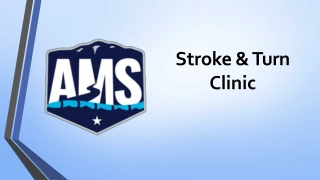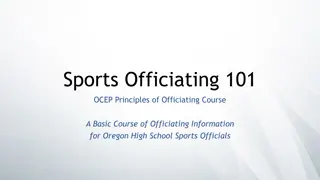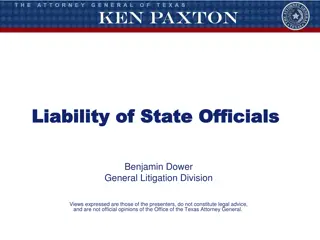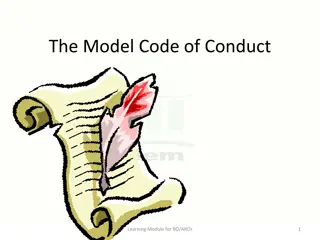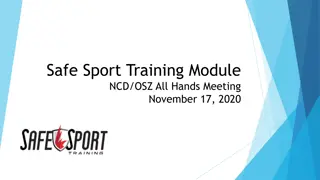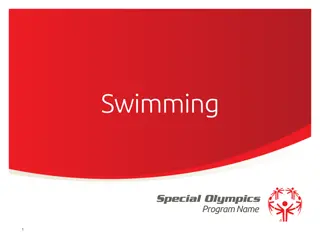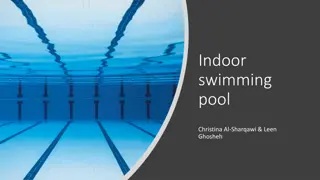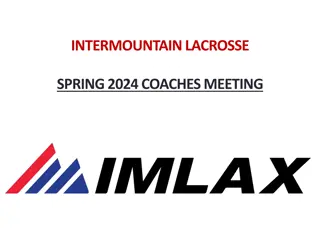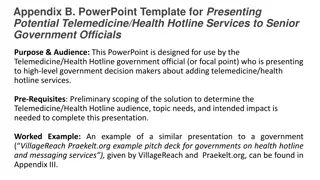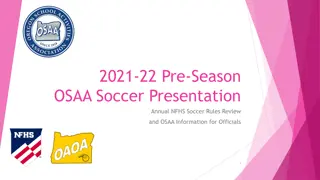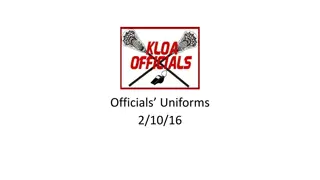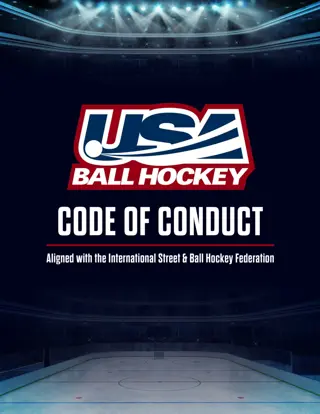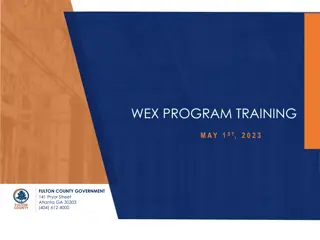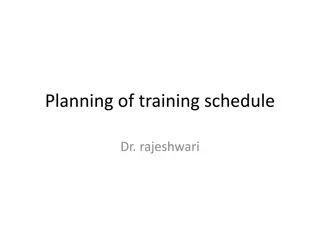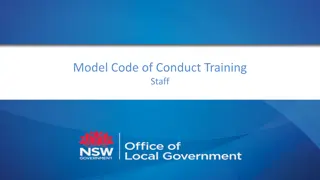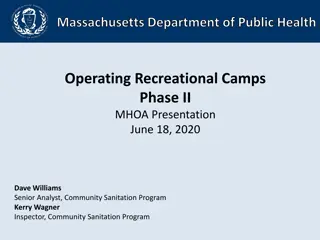Introduction to USA-S Swimming Officials Training
This content provides an overview of the USA-S Swimming Officials Training program, including course objectives, training agenda, reasons for officiating, and the mission of USA Swimming. It emphasizes the role of officials as ambassadors for the sport, their responsibilities during swim meets, the certification process, and the values upheld by the organization. The content also highlights the benefits of becoming an official, such as engaging with athletes, building friendships, and contributing to the swimming community. It ends with an introduction to the USA Swimming organization and its structure at the national and local levels.
Download Presentation

Please find below an Image/Link to download the presentation.
The content on the website is provided AS IS for your information and personal use only. It may not be sold, licensed, or shared on other websites without obtaining consent from the author. Download presentation by click this link. If you encounter any issues during the download, it is possible that the publisher has removed the file from their server.
E N D
Presentation Transcript
Beginning Stroke and Turn USA-S Officials Training V 3.4 Morning Session 10/3/2019 v. 3.4 1
Beginning Stroke and Turn Course Objectives Understanding the charter of the USA-S Organization Understanding and application of technical stroke rules Procedure of disqualification and filling out the DQ Slip Overview of a swim meet from the official s perspective Certification Requirement and Process 10/3/2019 v. 3.4 2
Training Agenda Introduction Why officiate? Technical rules, and DQ s Stroke and Turn in action Deck Time Anatomy of a swim meet The Certification Process 10/3/2019 v. 3.4 3
Why Officiate? 10/3/2019 v. 3.4 4
USA Swimming Mission Statement USA Swimming is the National Governing Body for the sport of swimming. We administer competitive swimming in accordance with the Olympic & Amateur Sports Act. We provide programs and services for our members, supporters, affiliates and the interested public. We value these members of the swimming community, and the staff and volunteers who serve them. We are committed to excellence and the improvement of our sport. We are committed to providing a safe and positive environment for all members. -Vision: To inspire and enable our members to achieve excellence in the sport of swimming and in life -Core Objectives: Build the base, promote the sport, and achieve competitive success . 10/3/2019 v. 3.4 5
Why do you want to be a USA-S official? Officials are ambassadors for the sport of swimming: They support the athletes and coaches, by ensuring swimming competition is conducted in a safe and fair manner for all and also get to watch some great swimming while doing their jobs. What is your interest in becoming an official? Being part of the meet versus a spectator, interacting with athletes and coaches Developing a passion for swimming by building knowledge and new skills Building friendships with officials across the zone, LSC and nation: becoming part of the larger officials community The Perks Officials parking, hospitality, and a starbucks card! Hanging out at a swim meet in the parent tent with nothing to do not fun! Letting our kids take responsibility for themselves by getting out of their way Volunteer hours are not a problem!! Giving back 10/3/2019 v. 3.4 6
USA Swimming Organization: USA Swimming National organization responsible for technical rules, by-laws Local Swim Committee 59 LSCs Pacific Swimming (PC) Zones in Pacific Swimming Zone 1 South - South San Francisco Bay, Santa Cruz, and Monterey Zone 1 North Peninsula from Sunnyvale to San Francisco Zone 2 East Bay Zone 3 North Bay Zone 4 Lake Tahoe, Reno 10/3/2019 v. 3.4 7
Philosophy of Officiating Everything is grounded in the rules. The rules define what is legal and what is not. Graceful Legal; Ugly Illegal Observers, not inspectors or coaches Observation should be consistent for all rules and all swimmers Do NOT infer or extrapolate Swimmer ALWAYS gets the benefit of the doubt!! 10/3/2019 v. 3.4 8
Uniform and Self-Presentation Uniform Requirements: (Khaki or Navy) pants or knee-length shorts or skirt (not jeans) White polo shirt, tucked Belt Primarily white tennis shoes, or boots White socks Credentials, and nametag (lanyard or not?) Look professional at all times! USA Swimming has begun using black pants and black shoes at some meets 10/3/2019 v. 3.4 9
The Technical Rules 10/3/2019 v. 3.4 10
The Four Competitive Strokes Butterfly Backstroke Breaststroke Freestyle 10/3/2019 v. 3.4 11
The Technical Rules The Technical Rules for each competitive stroke are broken down in the USA-S Rule Book into the following components to describe a legal swim: Start Stroke Kick (except backstroke & freestyle why?) Turn Finish 10/3/2019 12 v. 3.4
Definitions Arm--that part of the body that extends from the shoulder to the wrist Body--the torso, including the shoulders and hips Finish--the instant that a swimmer touches the wall at the end of the prescribed distance May--permissive, not mandatory Shall--mandatory 10/3/2019 v. 3.4 13
Definitions continued: On the back--position of the body when the shoulders are at or past vertical towards the back On the breast--position of the body when the shoulders are at or past vertical towards the breast Propulsive--having the power to propel Scissors kick--using the top of the instep of one foot and the bottom of the other foot in the propulsive part of the kick 10/3/2019 v. 3.4 14
More Definitions: Simultaneously Occurring at the same time Touch Contact with the end of the course Turn A point where the swimmers reverse or change direction Vertical Perpendicular to the water surface Horizontal Parallel to the water surface Wall Vertical portion of the pool, contiguous surfaces of the deck and overflow gutter, the front portion of the starting block or platform, or the touchpad at the end of the course Glossary at front of rule book and is reference for all the above definitions 10/3/2019 v. 3.4 15
Butterfly (Rule Book: 101.3) Phase of Swim Elements of Phase Start 101.3.1 Forward start Stroke 101.3.2 Body kept on Breast Multiple kicks permitted but first arm pull (stroke) must bring swimmer to the surface of the water Must break surface throughout the race except swimmer may be submerged after start and each turn not more then 15 meters where head must break the surface Arms, shoulders to wrists , brought forward over the water and pulled back simultaneously Simultaneous up and down movement No alternating, scissors or breaststroke kicking movements Kick 101.3.3 Turn/Finish 101.3.4&5 Shoulders at or pat vertical toward the breast when the swimmer leaves the wall Touch shall be made with both hands separated and simultaneous at, above or below the water 10/3/2019 v. 3.4 16
Breaststroke (Rule Book: 101.2) Phase of Swim Elements of Phase Forward start Start 101.2.1 Stroke 101.2.2 Body kept on the breast Stroke cycle is one arm pull and one leg kick in that order. Simultaneous arm movement in the same horizontal plan After the start and at each turn, the arm stroke may be completely back to the legs. Head must break the surface at the widest part of the second pull Recovery of the hands from the breast on, under or over the water. Elbows under the water except last stroke before turn, during the turn, and at the finish After start and each turn, prior to the first breaststroke kick, a single butterfly kick is permitted before, during, or after arm pull Movement of the legs must be simultaneous and in same horizontal plane without alternating movement Feet turned out during propulsive part of kick No alternating, scissors or butterfly kick except as stated is allowed Kick 101.2.3 Shoulders at or past vertical toward the breast when the feet leave the wall Touch shall be made with both hands separated and simultaneously at, above or below the surface of the water At the last stroke before the touch at the turn and the finish, an arm stroke not followed by leg kick is permitted Head may be submerged after the last arm pull prior to the touch, provided it breaks the surface of the water at some point during the last complete or incomplete stroke cycle proceeding the touch Turn/Finish 101.2.4 10/3/2019 v. 3.4 17
Backstroke (Rule Book: 101.4) Phase of Swim Elements of Phase Start 101.4.1 In water facing start end with hands on gutter or starting grips Guttered pool feet and toes may be above the water but may not be in, above or on lip or bent over the gutter anytime before or after the start Flat wall pads toes may be placed above the water line When using backstroke ledges the toes on both feet must be in contact with the wall Any style as long as the swimmer remains on their back Must break surface throughout the race except swimmer may be submerged after the start and each turn not more then 15 meters where the head must break the surface During turn, the swimmer can turn past vertical toward the breast and may utilize a continuous single or continuous double arm pull to initiate the turn Some part of the swimmer must touch the wall at the conclusion of each length Shoulders at or past vertical toward the back when the feet leave the wall Some part of the swimmer must touch the wall while on the back Stroke 101.4.2 Turn 101.4.3 Finish 101.4.4 10/3/2019 v. 3.4 18
Freestyle (Rule Book 101.5) Phase of Swim Elements of Phase Start 101.5.1 Forward start Stroke 101.5.2 Any style may be used (except medley relay or individual medley where freestyle must be any style other than butterfly, breaststroke, or backstroke) Must break surface during the race except swimmer may be submerged after start and each turn not more than 15 meters where the head must break the surface. Turn/Finish 101.5.3 & 4 Some part of the swimmer must touch the wall on the completion of each length and after completing the required distance 10/3/2019 v. 3.4 19
Individual Medley (Rule Book: 101.6) IM Elements of Phase Start 101.6.1 Forward Start Stroke 101.6.2 Rules for each stroke apply Must swim of event distance in prescribed stroke, in order Butterfly, Backstroke, Breaststroke and Freestyle May not swim in the style of the other three strokes during the freestyle leg Kick Rules for each stroke apply Turns/Finish 101.6.3 & 4 Intermediate turns conform to the turn rules of each stroke Transition turns conform to the finish rules of each stroke 10/3/2019 v. 3.4 20
Disqualification Process 10/3/2019 v. 3.4 21
Disqualification (DQ) process: If you see something, don t be afraid to call it Don t expect the other judge to call it Raise your hand keep it up so referee/chief judge can see it Note: lane, heat, event (correct swimmer!), infraction Jot down notes (cheat sheet) Once swimmers leave your jurisdiction: write the DQ Step back, take your time!, focus, take a breath Coverage while writing DQ 10/3/2019 v. 3.4 22
DQ slip details: When writing the DQ make sure: Take your time, fill it out completely and neatly Circle the infraction(s) Sign as judge Medley: write number code(s) in space Obtain swimmer s name from timers Notify swimmer if you can, yellow slip goes to the swimmer Turn in white DQ to the deck referee Be available to answer questions/clarifications if needed 10/3/2019 v. 3.4 23
Athlete Notification When notifying an athlete, make sure you do the following: Ask the athlete to step behind the timers Remove sunglasses and get down to eye level with the athlete Apply the "sandwich technique compliment, DQ, encourage Explain to the athlete what you observed, and why that resulted in the DQ Give athlete the yellow copy, and ask him to bring it to the coach (per USA-S rules, officials are required to make an attempt to notify the athlete or coach that they have been disqualified) Please do not Coach the athlete (that is not in your job description) Use arm or leg movements to explain the disqualification 10/3/2019 v. 3.4 24
Things you should do: Judge per the rules, not style lack of mastery does not mean the stroke is not legal Know your jurisdiction (discussed later) Judge fairly and evenly: all swimmers equal Learn effective positioning Experienced, novice, younger, older: all the same! be objective, you are a judge. Benefit of doubt always goes to the swimmer If you have questions ask team leader or chief judge, don t be afraid to ask! 10/3/2019 v. 3.4 25
Avoid at all Costs Coach an athlete who was disqualified Discussion of DQs with parents, athlete or coaches-- refer parents to the coach and the coach to chief judge/deck referee Don t take it personally if your call is overturned Don t avoid DQ ing athlete because you feel badly for him/her. This is part of the learning process for the swimmer Don t favor any swimmer, team, friend, etc. We Observe versus scrutinize the athletes (no over-judging) 10/3/2019 v. 3.4 26
Protests The swimmer s coach is responsible for protesting a DQ. Parents may NOT protest a DQ. Protest is initiated through the Chief Judge or Referee. Stroke & Turn Officials should not discuss DQs with coaches or parents. The Chief Judge or Referee is responsible for investigating the DQ. The Referee will make the determination to uphold or overturn the DQ based on the investigation 10/3/2019 v. 3.4 27
Protests The following are questions that you may be asked by the Chief Judge or Referee: What is your jurisdiction? Was the infraction yours to call? Where were you standing? Were you standing in a position such that you can observe the infraction you called? What did you observe? In few words, describe what you saw the swimmer do. For example, at the finish of the race, the swimmer reached and touched the wall with their left hand and then the right hand. What was the infraction? Does the infraction match what was observed? 10/3/2019 v. 3.4 28
Beginning Stroke and Turn USA-S Officials Training Afternoon Session 10/3/2019 v. 3.4 29
DQ Slip Walkthrough Gentlemen, this is a football . In only five words, Vince Lombardi communicated his point: We re going to start with the basics and make sure we re executing all the fundamentals. Ladies and gentlemen, this is a DQ slip 30 10/3/2019 v. 3.4
Rules Pertaining to Relay Races (Rule Book: 101.7, 102.3.7, & 102.13) General & Phase of Relay Elements of Phase General 101.7.4(A)(D) 102.3.7 102.13.6(A) 102.13.6(B) No swimmer shall swim more than one leg of any relay event Any relay team member and his/her relay team shall be disqualified from a race if a team member other than the swimmer designated to swim that leg enters the pool in the area where the race is being conducted before all swimmers of all teams have finished the race. Exception: When an in-the-water start is required or such start is approved by the Referee Any changes in the names of the competing swimmers or the order of swimming must be declared to the Head Lane Timer prior to the start of the heat in which such relay team is entered. No changes will be permitted thereafter. The take-off judge shall stand so that they can clearly see the feet of the departing swimmer and the touch of the incoming swimmer If dual take-off judging is used, lane and side judges shall independently report infractions in writing without the use of a hand infraction signal A relay team is disqualified if both judges report a disqualification 10/3/2019 v. 3.4 31
Rules Pertaining to Relay Races (Rule Book: 101.7, 102.3.7, & 102.13) (Cont.) General & Phase of Relay Elements of Phase Starts 101.7.4(C) In relay races a swimmer other than the first swimmer shall not start until his/her teammate has concluded his/her leg Finishes 101.7.4(B)(E) When automatic relay take-off judging is used, each swimmer must touch the touch-plate or pad in his/her lane at the end of the course to have finished his/her leg of the relay race Each relay team member shall leave the water immediately upon finishing his/her leg except the last member Take-Offs 101.7.4(F)(G) In relay races the team of a swimmer whose feet have lost touch with the starting platform before his/her preceding teammate touches the wall shall be disqualified In relay races involving in-the-water starts, the team of a swimmer who has lost touch with the end of the course before his/her preceding teammate touches the wall shall be disqualified, unless the swimmer in default returns to the original starting point at the wall. 10/3/2019 v. 3.4 32
Relay Race Medley relay vs individual medley: Sequence differs Individual Medley: fly, back, breast, free Medley Relay: back, breast, butterfly, free (alphabetical) Free relay Early takeoffs: feet leave hands have touched, toes to touch Double confirmation needed for early take off DQ 10/3/2019 v. 3.4 33
Jurisdiction The specific area of the pool that you will be responsible for judging including Which lanes and what part of those lanes Walkers versus Turn Judges (LC) 15 meter mark This will vary from meet to meet Short Course 25 yard pool Long Course 50 meter pool Championship Meet 10/3/2019 v. 3.4 34
Positioning All about trying to get the best view of the athletes in your jurisdiction. More difficult the more lanes you have to watch When there are no restrictions (like starting blocks), don t be afraid to move around to get that best view Typically easiest on turn end of pool Presentation of some scenarios on easel o o
The Anatomy of a Swim Meet 10/3/2019 v. 3.4 36
Organization of Officials Meet Referee (MR) Admin Referee (AR) OR Admin Official (AO) Chief Judge (CJ) Head Starter Deck Referees (DR) Deck Starters (SR) Assistant Chief Judges (ACJ) Stroke and Turn Judges (S&T) Assistant Admin 10/3/2019 v. 3.4 37
The Professional S&T Official Timely arrival Appropriate attire Professionalism Interaction with other volunteers Just like swimmers, becoming a good official takes work/experience Be aware of your behavior even when not officiating 10/3/2019 v. 3.4 38
When you arrive Check in with CJ or Meet Referee Sign in, make sure you bring your credentials and they are up to date (Deck Pass OK) Confirm the time and location of the Official s Meeting If applicable, take care of your family first so you can . Be on time for the official s meeting! 10/3/2019 v. 3.4 39
The Officials meeting Meet the senior and other officials for the meet Learn how this meet is going to run Learn what team you will be assigned to Review stroke and turn rules 10/3/2019 v. 3.4 40
Things you will learn at the meeting Pool deck orientation: Where things are First Aid, Hospitality, rest rooms, etc. Expectations for the meet Timeline, jurisdictions, pool setup, and overall staffing Any special considerations or other information, issues will be conveyed here 10/3/2019 v. 3.4 41
More things you will get at the meeting Jurisdiction for officiating Officiating teams/team leaders Rotations Timing of rotations and breaks Stroke briefing review of technical rules for ALL strokes Focus is not on one stroke/infraction If you have a question regarding a specific rule, take to your CJ one on one, do not bring it up at the meeting Notification of swimmers for DQ s Other things for you to be aware of while on deck v. 3.4 42 10/3/2019
Safety: we are marshals as well Safety - in the water and on deck No Glass Containers on deck No pets on deck No running, horseplay Three point entry into warm up area (no diving) No photography/videos from behind the blocks Remember 25 yard events starting on the turn end Photography/videos allowed toward the turn-side of the starting area 10/3/2019 v. 3.4 43
The Certification Process 10/3/2019 v. 3.4 44
Certification Requirements Stroke & Turn L1 1. Attend a Clinic Formal Classroom Training 2. Register with USA-S (non-athlete) 3. Pass Level II Background Check 4. Complete Athlete Protection Training 5. Pass Online Certification Test 6. Concussion Training (varies from LSC to LSC in California, a state requirement) Steps 1 - 6 are required to become an apprentice (T1) Work as an apprentice (T1) Be evaluated at two 2-day meets and recommended by two different Meet Referees Final evaluations must be in your zone NOTE: Final decision for promotion is made by the Zone Official s Chair 10/3/2019 v. 3.4 45
Certification Requirements Certification Levels T1 certification Apprentice Level Can work unsupervised on deck (making calls, writing slips) L1 Certification Entry Level S&T Mainly works at Zone Meets L2 Certification Works at LSC Meets Works as a CJ Mentoring Understands the operations of a swim meet L3 Certification Seen as an expert in both the Zone and LSC Leadership qualities 10/3/2019 v. 3.4 46
Certification Requirements: Shadowing Shadowing is training by observing a certified official perform their duties as a Stroke and Turn including: Team, jurisdiction, and rotations Calling an infraction by raising their hand Filling out the disqualification slip Interaction with other officials e.g. chief judge, deck referee, starter Critical component of the training process for an official No pre-requisite required to shadow at a swim meet S&T Trainees are encouraged to shadow after they complete their clinic until they receive their T1 (Z1S varies a bit from zone to zone) If you plan to shadow, attend the officials meeting at the beginning of the session and sign-in as a shadow. 10/3/2019 v. 3.4 47
Certification Requirements: Apprentice or Trainee An Apprentice (also referred to as a Trainee or T1) is a non-certified official who continues to learn and develop their skills by working as a S&T under the direct supervision of a certified official, CJ, or Meet Referee. Requirements for becoming an apprentice include the following: Attend a clinic (formal training) Register with USA-S as an official Pass Level II Background check Complete the Athlete protection training (APT)/Concussion Pass the S&T/Timer On-line certification test Official Trainees should work several sessions as an apprentice to develop their skills prior to their first and second evaluations: Take advantage of shadowing before working as an apprentice Make sure you feel comfortable working as an apprentice before asking for your first evaluation (this isn t a race) 10/3/2019 v. 3.4 48
Certification Requirements: Evaluation Process Final Step of certification process (must be T1 to be evaled in Z1S) 2 evaluations and recommended by two Meet Refs For each eval, must work two days or more at a 2+ day Meet Highly encouraged to work 2-4 sessions between initial and final evaluation Zone Official s Chair makes final decision Not pass or fail, but provides feedback regarding where a person is in their development process, and if they are ready to work independently 10/3/2019 v. 3.4 49
Certification Requirements cont: Evaluation form (can be found at pacswim.org) What are we looking for in an L1 Official: Open to receiving and incorporating feedback Team player Understanding of technical rules and ability to apply them in typical situations Understands Meet protocols (official s meeting, jurisdictions, teams, rotations, DQ process) Ample time on deck working as an apprentice 10/3/2019 v. 3.4 50


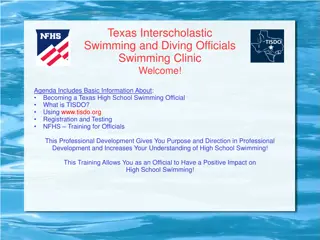
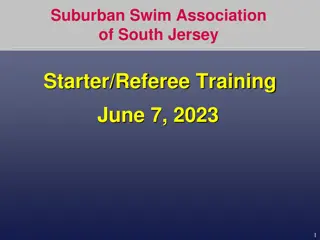
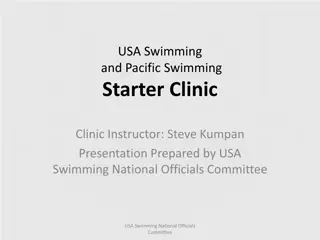
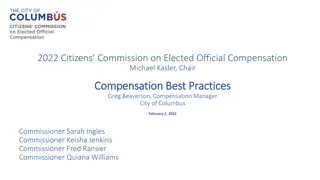
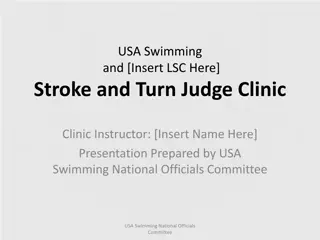
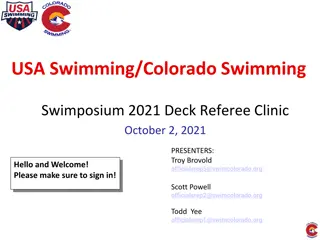
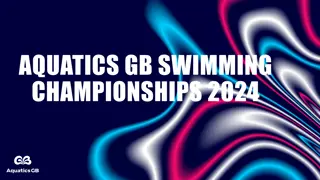
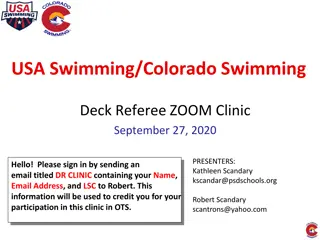

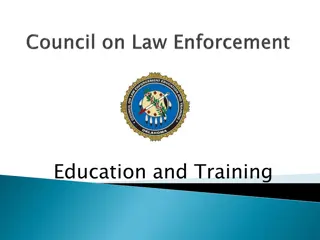
![USA Swimming and [Insert LSC Here] Starter Clinic Overview](/thumb/162824/usa-swimming-and-insert-lsc-here-starter-clinic-overview.jpg)
